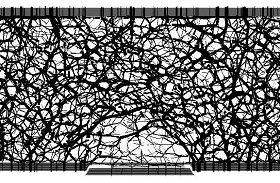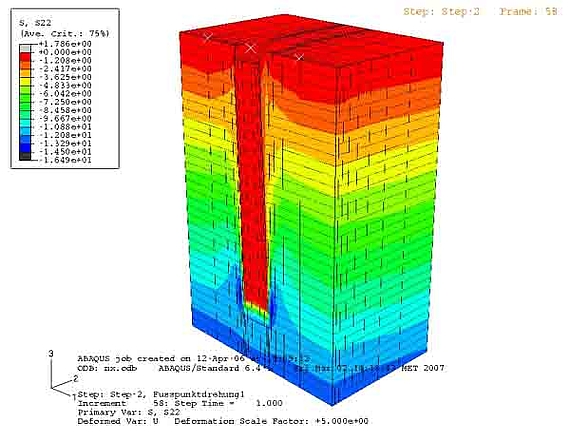Experimental and Numerical Investigations on the Active Spatial Earth Pressure
Prof. Dr.-Ing. Martin Achmus / Dipl.-Ing. Florian tom Wörden
Introduction



When a structure translates in a direction away from the adjacent soil, the soil pressure acting on the structure continually decreases with the displacement until a minimum value is reached. This value is known as the active earth pressure. The value of the active earth pressure acting on a structure is mainly determined by the geometrical properties, i.e the height to width ratio (n=height/width), of the structure as well as from the soil parameters. For structures with a small value of n, the active earth pressure can be considered in a plane strain case, whereas for large values of n, a spatial active earth pressure is considered, whose value is less than that in a plane strain case.
Active earth pressure problems that are considered to act spatially occur e.g. on excavated slurry walls and boreholes, shaft constructions, narrow earth or trench excavations, tension abutments and anchor plates, as well as in tunnelling excavations. There are several methods available that are used to calculate the active spatial earth pressure. However, most of the methods are limited to analyzing a slurry-supported trench excavation, i.e. a soft wall with no wall friction. Currently, only the modified element slice theory from Walz and the method outlined in DIN 4085 are capable of calculating the active spatial earth pressure for other cases. Moreover, a comparison of the methods to determine the active spatial earth pressure for the case of a slurry wall shows widely discrepant values.
Consequently, there exists a need to clarify the geometry-dependent reduction of the active spatial earth pressure as compared to the plane strain case. Furthermore, a method to determine the active spatial earth pressure for rigid structures with wall friction should be proposed.
For this purpose, experimental and numerical investigations on the active spatial earth pressure acting on rigid structures are conducted at the IGBE. In the experimental investigation, a rigid structure with a spatial geometric ratio between 2 < n < 8 is displaced actively (away from the soil) in a sand-filled earth pressure test pit (length [m] x width [m] x height [m] = 0,9 x 1,2 x 1,7 ). The experimental tests are modelled numerically using the Discrete Element Method (DEM) and Finite Element Method (FEM), respectively. Through DEM modelling, the process of stress redistribution that leads to the reduction of the active earth pressure can be analyzed and illustrated (see Fig. 1).

The FEM model allows a three-dimensional parametric study for the investigation of the geometric as well as soil mechanical variables to be conducted.
Publications
[Translate to Englisch:] [1] tom Woerden, F., Achmus, M., Abdel-Rahman, K. (2004). Finite element and discrete element modelling for the solution of spatial active earth pressure problems. Numerical Modeling in Micromechanics via Particle Methods. Shimizu, Hart & Cundall (eds.)














